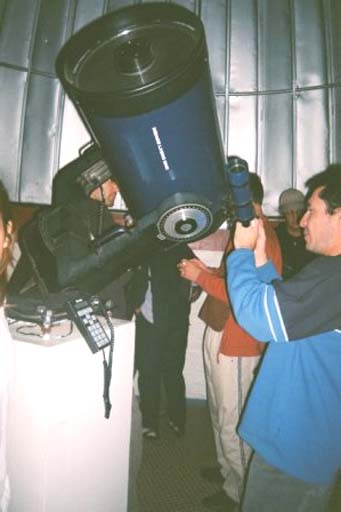Starry Starry Night
5 December 2005 (Monday) – La Serena, Chile
I spent the day enjoying the centre of La Serena. Walking from Claudio’s house to the centre, based on the clean streets, the lovely houses, the flower gardens, the blue and sunny sky, it actually reminded me of some southern beach towns in Australia. Hard to believe that I was still in South America. Where are the adobe mud houses? Where are the rubbish?
But one thing still remained were the election campaigns. What a strange coincidence! Peru is having its Presidential election soon… next Jan, I think, Bolivia is having its on 18 December and Chile, 11 December.
In Peru, they painted the names of the President elects on the walls of the adobe mud houses of poor campesinos all over the countrysides. Only the names are shown, so I had no idea how the candidates look like. But it was not important to the campaigners, as they just wanted to use repetitions (by displaying the elects’ names everywhere) to ‘train’ the campesinos who to vote for.
In Bolivia, besides painting the walls of houses and rocks along the highways, they have quite a lot of posters and banners as well, shoving the faces of the candidates down our throat. Besides this, they provide very important ham sandwiches to the masses who gathered for the ‘rallies’.
In Chile, there were even more posters and banners – politicians trying on their most uncorrupt looks. There are few parks empty of these free-standing A-frame poster stands, few lamp-posts free of the posters, few walls free of the banners. Interestingly, quite a handful of them had been viciously destroyed, the faces cut out, the posters ripped to bits and scattered on the road.

Another strange sight I started to notice was pregnant women. Pregnant women, now why do they look so unfamiliar? It slowly dawned on me that, gosh… for over a month now, while I had seen tonnes and tonnes of babies strapped to the backs of the Peruvian and Bolivian indigenous women, I had not really noticed any pregnant women there. Why?? Were they hidden from sight? Or were they already so fat that it was not obvious, or the protruded stomachs had lain hidden underneath the folds of their flouncy skirts? The things you notice as you travel…
What a small town La Serena is. I actually RAN into Claudio, ONE of the two persons I know here, on the streets. He had gone to try and get his pay from an employer. Claudio works as a freelance agronomist. This employer had owed him money since late October. And when Claudio said he had no money yesterday, he really meant he had NO MONEY, not on him, not in his bank account. Sheesh, poor dear. He got the cheque today, but there was no money in the bank account of his employer to draw from. He looked crestfallen, tomorrow he will try again. Hahaaa… we had talked about going to Coquimbo’s fish market for seafood lunch today. Nope, no such chance. We had to go home and rustled something up, like Maggi noodles, for lunch.
While it is really hot and sunny in the day, it gets really chilly at night. OK, it’s Chile after all. In the evening, I put on more layers and waited outside Claudio’s house for my pickup for a visit to Observatory Mamalluca, about 1 hour’s drive away from La Serena. This is an astronomical observatory centre open to the public.
We were given a presentation to learn some new starry terms like nebula, clusters, supernova, etc… I wish I could in turn tell you exactly what they are but in fact, I did not quite understand them myself.
Then, we were divided into groups and escorted first to the large telescope located at the top. There is a round roof and they opened a small gap and aimed the telescope at Venus. Wow, it sure feels like being in one of those science-fiction movies!

While Venus looks extremely bright, always hanging rather close to the moon, it was actually at a crescent shape now. We saw it shining all bright and white and sexily skinny through the telescope.
Then, Luis, the guide, aimed at the moon. As the moon is much closer and this telescope was really quite powerful, we could see the craters and valleys really clearly. A good thing was that the moon was a crescent now, so there are shadows and light, making it easier to see the craters. On a full moon here, no one works, everyone sleeps.
![The crescent moon [by PC]](http://blogs.bootsnall.com/trisha/files/2006/02/LaSerena_moon1.jpg)
![On closer inspection... [by PC]](http://blogs.bootsnall.com/trisha/files/2006/02/LaSerena_moon2.jpg)
We looked at Mars and several more clusters (4 or more stars together form a cluster, now I know).
Later, out on the field, Luis used this amazing light-pointer to show us the constellations. The light-pointer had a laser light that seemed to reach the stars and he could point out Taurus, Aries, Aquarius, Capricorn, Sagittarius to us. Naturally, there was Orion to marvel at, now that we are in summer here. We had to use a little of our imagination for the Rabbit, the Toucan, the River… but wow, fascinating!!
The Southern Cross (with 5 stars, like in the Australian flag) is unfortunately now below the horizon and we could only see it in a few hours. He explained that 4 and a half times the distance from the Southern Cross would lead us to the Southern Polaris (the southern version of the North Star) – the point that does not move, the point where all the stars rotate around, and the point that is, for sure, pointing – south. But meanwhile, there is the False Cross (with 4 stars) nearby. OK, now we know not to confuse the Southern Cross with the False Cross. Very important.
He pointed out the 2 brightest stars – Sirius and Canupos. Sirius, the brightest, is only 8.2 light years away, but Canupos is like 100 light years away. So, if they are both in the same distance, Canupos would blind you right out.
We observed more of Orion, whose alpha star (the brightest in the constellation) was glowing red. That was because it was very old, and very cold, ready to explode and die out. It is 300 light years away. Perhaps it had already exploded and died, we just did not know yet. Perhaps it had exploded and died exactly 300 years ago tonight and we would see it extinguished right now. Gosh, sad to think Orion without one of the ‘shoulders’.
OK, this is the part I am a little confused with. Anyway, this is what I thought was explained to me. I am stating now that I am absolutely NOT sure about this. Stars are born out of nebulas. But as the stars die out, they form nebulas again which then, new stars are born. OK, assuming what I just wrote is right, isn’t it beautiful? The cycle of life.
The bluest stars are the hottest. The red ones are the coldest. More than 50% of stars are in pairs. Less than 1% are solo-stars, an example is the Sun. The Sun, in comparison, is very small, had been born ‘yellow’, so it was actually not very hot, compared to the ‘blue’ stars. But, in about 5 billion years’ time, it would grow larger, become red and get ready to die. As it grows larger, Mercury, Venus, Earth and Mars would be engulfed in the Sun.
Well, certainly not our problem.
This is my first time in an observatory. I know there was no way I could remember the stars’ or clusters’ name, which are usually named in some letters and numbers or remember the light-years or whatever other statistics… but oh, what an experience here today, taking time out to appreciate the things much much much larger than life itself – the universe. How insignificant we are. How even more insignificant those vicious, back-stabbing, stupid bosses we work for are.
[photo credits PC – Pepe and Cris, thanks! See their blog (written in Catalan) http://www.loliplanet.com/]
Tags: 10) It's Chile Here, La Serena
